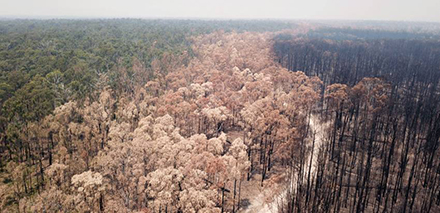Recent scientific studies into the 2019–20 black summer fires show timber harvesting had little impact on the extent and severity of the fires. [i] The studies conclude the extent and severity of the 2019–2020 bushfires were a result of years of below average rainfall, extreme fire weather and topography.
Additionally, authors of a 2022 paper published in Nature Ecology & Evolution note there has been no link made between forestry practices and the 2019–20 fires in either empirical research or government inquiries. [ii]
These papers add to the growing scientific consensus that the risk of more frequent and higher severity fires will continue to increase because of climate change.
With the increasing risk of fires threatening our forests and communities, researchers are investigating active forest management to find ways to increase forest resilience and reduce the risk of these landscape scale, high severity fires.
Active forest management is not new, it has been practiced by Aboriginal peoples to manage the land for millennia. In fact, research has shown the cessation of these cultural management practices had a profound impact on the landscape. [iii]
These active forest management practices are important for forest resilience, health and mitigation against catastrophic fires. One paper examining early colonial records from Victoria demonstrated the importance some colonists placed on Aboriginal knowledge of the landscape and the role fire played in firefighting and prevention. [iv]
These papers suggest, like the colonists, we need to learn from the traditional management practices to look after our forests into the future.
Another interesting area of research is on the role forest thinning may play as part of an overall strategy to reduce bushfire risk. In one paper, researchers look at commercial thinning of an ash stand on fuel loads, fire hazards and fire behaviour. [v]
This study found thinning decreased fuel load and fire hazard ratings and, when simulated extreme fire weather conditions were applied, the research found a reduction in fire intensity and rate of spread.
Last year, a review paper was published that examined international studies on thinning and prescribed burning. [vi]
This paper found thinning applied at a large scale combined with fuel reduction burning have the potential to reduce fire risks.
However, the review noted that most evidence arose from studies from the US and the researchers noted the need for more landscape-scale research to better understand the impact from a local perspective.
In a recent letter to the Canberra Times, Forestry Australia’s Vice President Dr Michelle Freeman called for ‘real solutions to Australia’s wicked bushfire problem that incorporate Traditional Owner practices, local communities and scientific management across all our forests to mitigate and manage future fire risks’.
Which is why as forest managers who care for the environment in which we work, we ensure we are across the latest research into forest resilience and reducing bushfire risk. Rigorous, evidence-based and independent scientific research informs our policies and practices when it comes to sustainable forestry.
[i] D.M.J.S. Bowman, G.J Williamson, R.K. Gibson, R.K. et al. (2021), ‘The severity and extent of the Australia 2019–20 Eucalyptus forest fires are not the legacy of forest management’, Nature Ecology & Evolution, Vol. 5, pp 1003–1010, https://doi.org/10.1038/s41559-021-01464-6
J. Keenan, P. Kanowski, P. J. Baker, C. Brack, T. Bartlett & K. Tolhurst (2021), ‘No evidence that timber harvesting increased the scale or severity of the 2019/20 bushfires in south-eastern Australia’, Australian Forestry, Vol. 84:3, 133-138, https://doi.org/10.1080/00049158.2021.1953741
[ii] D.M.J.S. Bowman, G.J. Williamson, R.K. Gibson, R.K. et al (2022), ‘Reply to: Logging elevated the probability of high-severity fire in the 2019–20 Australian forest fires’, Nature Ecology & Evolution, https://doi.org/10.1038/s41559-022-01716-z
[iii] M-S. Fletcher, T. Hall, & A.N. Alexandra, A.N. (2021), ‘The loss of an indigenous constructed landscape following British invasion of Australia: An insight into the deep human imprint on the Australian landscape’ Ambio, Vol. 50, pp 138–149, https://doi.org/10.1007/s13280-020-01339-3
[iv] F. Cahir, I.D. Clark, D. Tout et al (2021), ‘Aboriginal fire-management practice in colonial Victoria’, Aboriginal History, Vol. 45
[v] L. Volkova, H. Bi, J. Hilton, C.J. Westona (2017), ‘Impact of mechanical thinning on forest carbon, fuel hazard and simulated fire behaviour in Eucalyptus delegatensis forest of south-eastern Australia’, Forest Ecology and Management, Vol. 405, pp 92–100, https://doi.org/10.1016/j.foreco.2017.09.032
[vi] R.J. Keenan, C.J. Weston & L. Volkova (2021), ‘Potential for forest thinning to reduce risk and increase resilience to wildfire in Australian temperate Eucalyptus forests’, Current Opinion in Environmental Science & Health, Vol. 23, https://doi.org/10.1016/j.coesh.2021.100280






